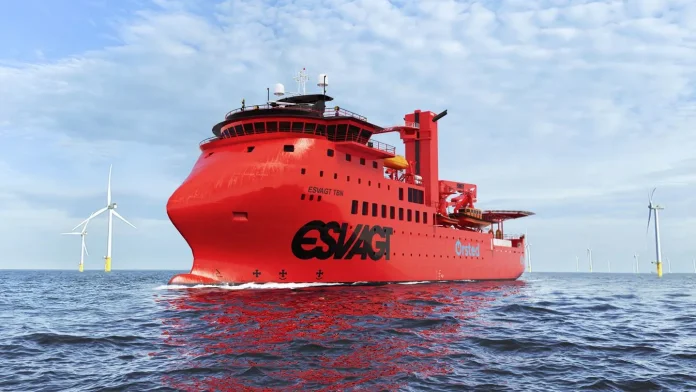As part of a new agreement, Ørsted and ESVAGT, an offshore wind service and support company, have decided to invest in the world’s first service operation vessel (SOV) that can operate on green fuels.
The SOV will be powered by batteries and dual-fuel engines, capable of sailing on renewable e-methanol, produced from wind energy and biogenic carbon. For the new SOV, Ørsted intends to supply the e-methanol.
An offshore wind farm already has 99% lower emissions than a coal fired power station, seen over the entire lifetime of the asset, including production, construction and installation. With this new agreement, ESVAGT and Ørsted are moving towards mitigating the remaining emissions.
ESVAGT will start building the vessel in the second quarter of 2022. Once commissioned by the end of 2024, the SOV will start servicing the world’s largest offshore wind farm, Hornsea 2, off the U.K.’s east coast.
“As the world leader in offshore wind, it’s natural for Ørsted to take the lead in driving out fossil fuels from the industry,” says Mark Porter, head of offshore operations at Ørsted. “We’ve set clear targets and a clear direction towards net-zero emissions, and this new methanol-powered SOV is a tangible proof of our clear commitment to realize these targets. The agreement with ESVAGT checks many boxes for us, as it both helps decarbonize our offshore operations while also demonstrating our strong belief that green fuels based on renewable energy is the most viable solution to create a green maritime sector.”
“This is an important milestone with real meaningful impact on the green transition,” comments Søren Karas, chief strategy and commercial officer at ESVAGT. “Ørsted and ESVAGT share an ambition for a sustainable future, and as an industry leader we’re committed to taking the lead in decarbonizing the maritime industry. We’re delighted and proud to be able to take this bold step together with Ørsted towards making offshore wind marine solutions fossil free with an innovative new solution.”
Ørsted has implemented a systematic approach for reducing emissions from its offshore logistics through efficiency initiatives, including route optimizations and sailing at fuel-saving speeds. Ørsted has also implemented light hybrid crew transfer vessels for increased fuel efficiency.
Servicing an offshore wind farm takes a great deal of effort and is handled by a highly specialized team of service technicians that are often offshore for weeks at a time. During their stay offshore, the technicians live on a SOV, which also hosts an on-board workshop and much of the equipment and spare parts needed to service an offshore wind farm.
The new ESVAGT SOV incorporates the newest technologies and the ESVAGT crew is highly trained and enabled by digital tools. The SOV is designed for comfort and high workability, providing a highly efficient workspace and safe transfer of technicians at the windfarm via a motion-compensated gangway and transfer boats as well as a crane to lift heavy spare parts. As a floating home, it also offers recreational activities for the on-board crew and technicians, including fitness facilities, a game room, a cinema and individual accommodation. The SOV is also equipped with a helipad for fast access and transfers from shore.




